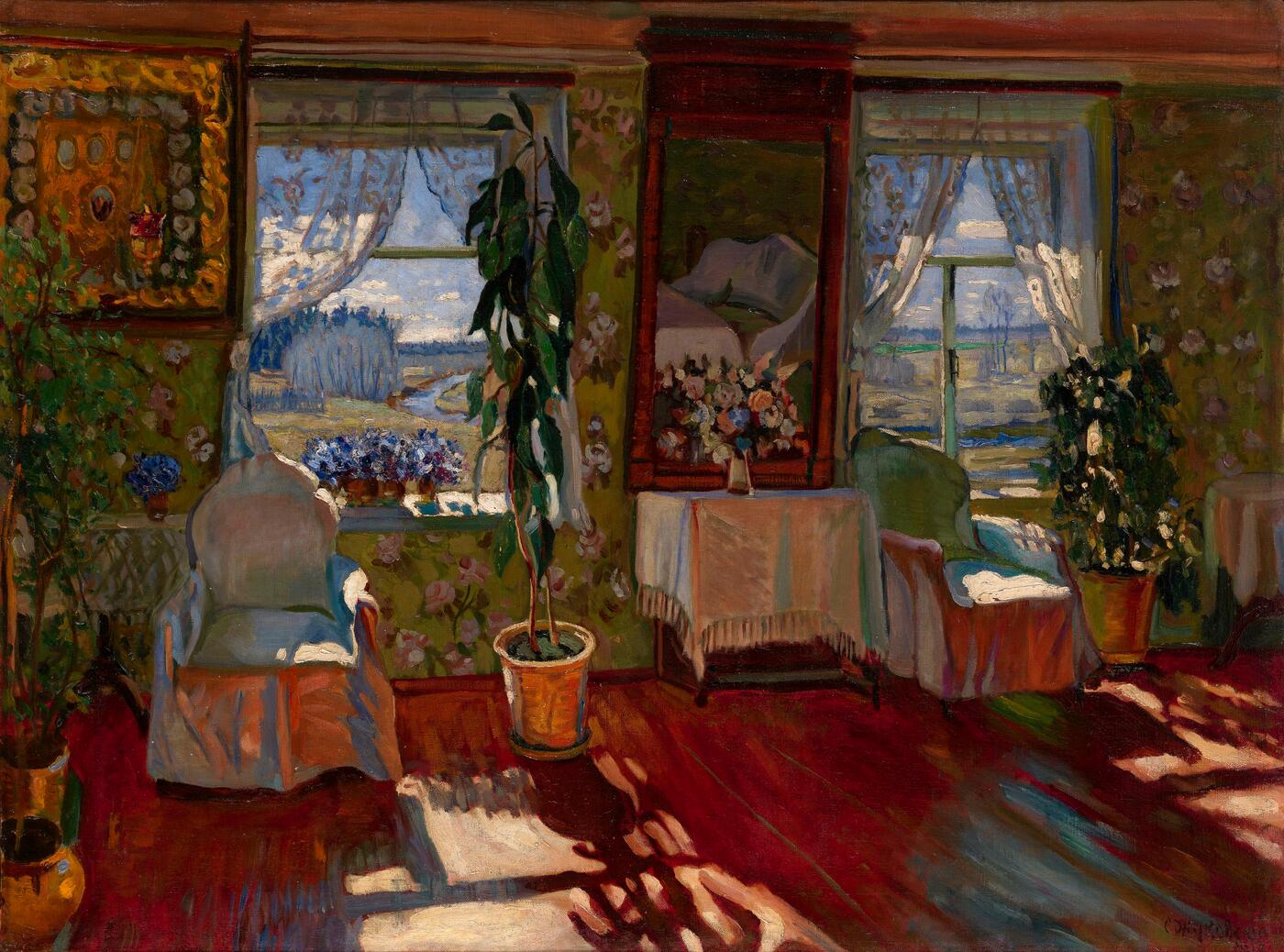MacDougall's Russian Art Auctions 27-30 May 2012
27 May 2012

*§ 131. ZHUKOVSKY, STANISLAV (1875-1944)
Interior, signed and dated 1917.
Oil on canvas, 79 by 106.5 cm.
200,000–300,000 GBP
Authenticity of the work has been confirmed by the expert V. Petrov.
Literature: R. Aldonina, Stanislav Zhukovsky, Moscow, Belyi Gorod, 2005, No. 177, illustrated.
The present work is without doubt one of the most cheerful and harmonious of Zhukovsky’s interiors.
The artist turned to this genre in the 1910s, when Petersburg society was feeling particularly acutely the worrying fragility and degeneration of the old way of life on country estates, which was fast disappearing under the unstoppable march of progress. The public was seized by, in the words of Alexander
Benois, “the beloved cherry orchard state of mind”.
The artist usually found his subjects in old houses with their libraries, drawing rooms, old furniture and portraits, which preserved vestiges of Russian culture and evoked feelings of nostalgia. Sometimes estateowners invited him to capture the hearth and home which were so dear to them. This was the origin of the series of interiors of the Grand Duke’s Bryansk estate. Sometimes it was the artist himself
who asked the owner’s permission to come and paint rooms which had caught his fancy or which had lodged in his memory. In a letter addressed to Dmitri
Sheremetev, Zhukovsky betrays his fascination with interiors: “Would you be kind enough to allow me to paint in your houses in Ostafievo and Kuskovo. I am
a great admirer of the old times… Here they speak so clearly and are so wonderfully, carefully preserved. I would like to do some interiors of this priceless memorial to a wonderful era. Unfortunately, they have been disappearing so rapidly in recent times and there are few genuinely cultured and refined people who can appreciate these sacred places and are not converting them to factories and using as firewood the parks where Eugene Onegin
once walked.”
In this case the emotional mood of the painting emanates from the ravishing expanse of distant countryside, flooded with bright summer sunshine. This light from the garden streams in through the open windows of the house, filling it with the living breath of summer, with a particularly joyful sense of the freshness and purity of country life. At the same time new beauty is revealed in the modest furnishings, in the wooden floor and in the old-fashioned flowered wallpaper, partially concealed by the loose covers of old armchairs and tubs of flowers, an enormous mirror and the Mother of God in a gold oklad and in the dainty mauve flowers on the window sill. The strong colour accents mature within this rich colour environment, resulting in true harmony, correspondingto the overall emotional character of the image.
According to the authors of the 1921 Zhukovsky exhibition catalogue, “in his depictions of interiors Zhukovsky demonstrates superb
taste and a poetic delicacy, capturing and revealing the intimate connection between things. Left by people, they retain their human language and the innermost part of the human soul. The people are accustomed to the stable comfort of their family traditions, they love the neglected cherry orchard, the old furniture and the chiming clock. They do not know hardship and cannot stand
the noise of street fights. It is not long ago that they abandoned their interiors. Will they go back? The things are silent on that count, only telling us about the irrecoverable past. This language of interiors is understood more clearly by the artist than the voices and faces of the inhabitants who have left them and Zhukovsky translates it to us extraordinarily faithfully and simply.”
His interiors seem to embody the movement of time, unexpectedly and painfully accelerating at the turn of the century. On the one hand they show the link between different times, reflecting the image of rooms from long ago, as if they had just been opened up after being closed throughout a long winter. But, on the other hand, it seems the inhabitants of these patriarchal rooms, guardians of the “beliefs of the good old days”, have just left for a moment, as witnessed by the shawl thrown over the back of the armchair and the wide-open window, or the open hatch of the stove, where a fire still burns. This is why the work of Zhukovsky, one of the most popular painters of the early 20th century, has
not lost its significance, even today.
Notes on symbols:
* Indicates 5% Import Duty Charge applies.
Ω Indicates 20% Import Duty Charge applies.
§ Indicates Artist's Resale Right applies.
† Indicates Standard VAT scheme applies, and the rate of 20% VAT will be charged on both hammer price and premium.